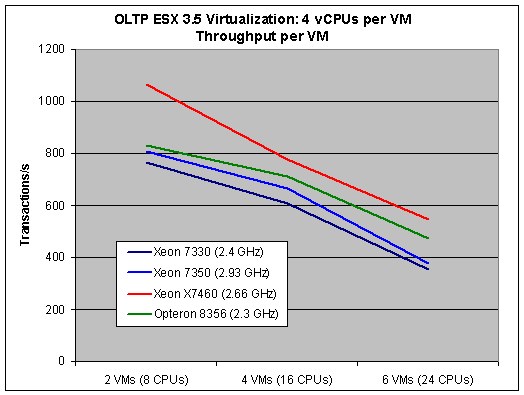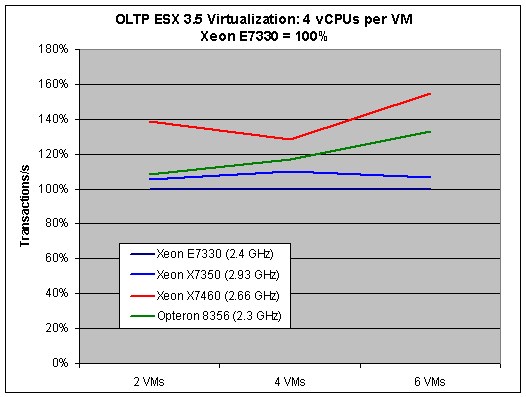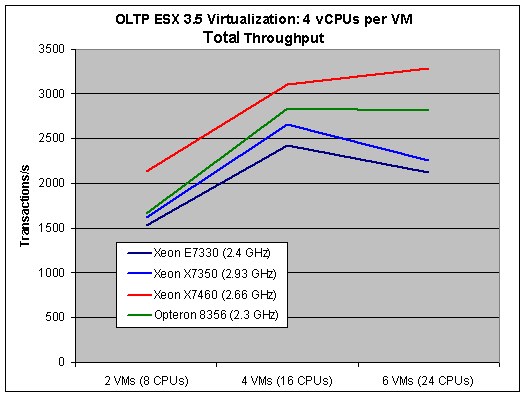Intel Xeon 7460: Six Cores to Bulldoze Opteron
by Johan De Gelas on September 23, 2008 12:00 AM EST- Posted in
- IT Computing
ESX 3.5 Update 2 Virtualization Results
Disclaimer: Do not try to interpret these results if you are in a hurry!
We apologize for this warning to our astute readers, for whom it will be obvious that you cannot simply take the following graphs at face value. Unfortunately, many people tend to skip the text and just look at the pictures, which could lead to many misinterpretations. We want to make it clear that when you combine three different software layers - Hypervisor, OS or "Supervisor", and Server Application - on top of different hardware, things get very complex.
In our very first virtualization benchmark, we give each VM four virtual CPUs. With two and four VMs, we do not "oversubscribe", i.e. each virtual CPUs corresponds at least one physical CPU. In the case of six VMs, we oversubscribe some of the servers: the Xeon 73xx (Tigerton) and Opteron (Barcelona) platforms only have 16 physical CPUs, and we allocate 24. Oversubscribing is a normal practice in the virtualization world: you try to cut your costs by putting as many servers as is practical on one physical server. It's rare that all your servers are running at 100% load simultaneously, so you allow one VM to use some of the CPU power that another VM is not currently using. That is the beauty of virtualization consolidation after all: making the best use of the resources available.
The virtual CPUs are not locked to physical cores; we let the hypervisor decide which virtual CPU corresponds to which physical CPU. There is one exception: we enable NUMA support for the Opteron of course. For now, we limit ourselves to six VMs as several non-CPU related (probably storage) bottlenecks kick in as we go higher. We are looking at how we can test with more VMs, but this will require additional research.
This limit is a perfect example for understanding how complex virtualization testing can get. We could disable flushing the logs immediately after commit, as this would reduce the stress on our disk system,and make it a more CPU limited benchmark even with more than six VMs. However, this would mean that our test loses ACID compliance, which is important for an OLTP test. In a native test, this may be acceptable if you are just looking to test the CPU performance; it's probably just a matter of adding a few more spindles. However, this kind of reasoning is wrong when you work with virtualized servers. By disabling the immediate flushing of logs, you are lowering the impact on the hypervisor in several ways. Your hypervisor has to do less work, hence the impact on the CPU is lowered, and the objective of this test is to see how well a CPU copes with a virtualized environment.
Consolidation courtesy of virtualization is a compromise between performance per VM and total throughput of the physical machine. You want to put as many virtual servers as possible on one physical server to maximize throughput and cost reduction, but you do not want to see individual VM performance decrease below a certain threshold. If you sacrifice too much individual virtual server performance in order to get more VMs on one server, your CFO will be happy but your users will complain. It is therefore important to look at both the performance per virtual server and total throughput of the physical machine. The first graph shows you the number of transactions per Virtual Server. For those interested, this is an average and individual virtual servers show +/-5% compared to this average.

As expected, the highest result per virtual server is achieved if we only run two VMs. That is normal, since it means that the physical server has eight CPUs left to handle the console and hypervisor overhead. Nevertheless, those two factors cannot explain why our results fall so much once we activate four VMs and all 16 CPUs cores are busy.
| Performance loss from 2 VMs to 4 VMs | |
| Xeon 7330 (2.4GHz) | -21% |
| Xeon 7350 (2.93GHz) | -17% |
| Xeon X7460 (2.66GHz) | -27% |
| Opteron 8356 (2.3GHz) | -15% |
Our internal tests show that you should expect the Hypervisor to require about 12% of the CPU power per VM and the impact of the console should be minimal. In the first test (two VMs) there is more than enough CPU power available as we use only half (Opteron 8356, Xeon 73xx servers) to one third (X7460 server) of what is available. The real performance losses however are in the range of 15% (Opteron) to 27% (Xeon X7460). So where is the other bottleneck?
The database is 258MB per VM, and therefore runs almost completely in our INNODB buffer pool. We suspect the extra performance comes from the extra bandwidth that two extra VMs demand. Notice how the Opteron - the server with the highest bandwidth - has the lowest loss. That gives us our first hint, as we know that more VMs also result in higher bandwidth demands. Secondly, we see that the Xeon X7350 loses a little less than the E7330 (percentagewise) when you fire up two extra VMs. The slightly bigger cache on the X7350 (2x4MB) reduces the pressure on the memory a bit.
Next, we compare the architectures. To do this, we standardize the Xeon E7330 (2.4GHz) result to 100%.

This graph is worth a very close investigation, since we can study the impact of the CPU core architecture. As we are using only eight CPUs and 4GB if we run two VMs, the Xeon 7460 cannot leverage its most visible advantage: the two extra cores. With two VMs, performance is mostly determined - in order of importance - by:
- (Futex) Thread synchronization (we have up to 32 threads working on the database per VM)
- Raw integer crunching power
- VM to Hypervisor switching time (to a lesser degree)
The X7460 is based on the Penryn architecture. This 45nm Intel core features slightly improved integer performance but also significantly improved "VM to Hypervisor" switching time. On top of that, synchronization between CPUs is a lot faster in the X74xx series thanks to the large inclusive L3 cache that acts as filter. Memory latency is probably great too, as the VMs are probably running entirely in the L2 and L3 caches. That is the most likely reason why we see the X7460 outperform all other CPUs.
Once we add two more VMs, we add 4GB and eight CPUs that the hypervisor has to manage. Memory management and latency become more important, and the Opteron advantages come into play: the huge TLB ensures that TLB misses happen a lot less. The TLB is also tagged, making sure "VM to Hypervisor" switching does not cause any unnecessary TLB flushes. As we pointed out before, the complex TLB of the Barcelona core - once the cause of a PR nightmare - now returns to make the server platform shine. We measured that NPT makes about a 7-8% difference here. That might not seem impressive at first sight, but a single feature capable of boosting the performance by such a large percentage is rare. The result is that the Opteron starts to catch up with the Xeon 74xx and outperforms the older 65nm Xeons.
The impact of memory management only gets worse as we add two more VMs. The advantages described above allow the Opteron to really pull away from the old Xeon 73xx generation. However, in this case the Xeon X7460 can leverage its eight remaining cores, while the Opteron and older Xeon servers do not have that luxury. The hypervisor has to juggle six VMs that are demanding 24 cores, while there are only 16 cores available on the Opteron and Xeon 73xx servers. That is why in this case the Xeon X7460 is again the winner here: it can consolidate more servers at a given performance point than the rest of the pack.
To appreciate what the 6-core Xeon is doing, we need to look at the total throughput.

Notice how the Opteron is able to keep performance more or less stable once you demand 24 virtual CPUs, while the performance of Xeon 73xx takes a nosedive. The winner is of course the Intel hex-core, which can offer 24 real cores to the hypervisor. The Dunnington machine is capable of performing almost 3300 transactions per second, or no less than 45% more than its older brother that is clocked 11% higher. The Opteron does remarkably well with more than 2800 transactions per second, or about 24% better than the Xeon that has twice the cache and a 27% better clock speed (X7350 at 2.93GHz).










34 Comments
View All Comments
npp - Tuesday, September 23, 2008 - link
I didn't got this one very clear - why should a bigger cache reduce cache syncing traffic? With a bigger cache, you would have the potential risc of one CPU invalidating a larger portion of the data another CPU has already in its own cache, hence there would be more data to move between the sockets at the end. If we exaggerate this, every CPU having a copy of the whole main memory in its own cache would obviously lead to enormous syncing effort, not the oposite.I'm not familiar with the cache coherence protocol used by Intel on that platform, but even in the positive scenario of a CPU having data for read-only access in its own cache, a request from another CPU for the same data (the chance for this being bigger given the large cache size) may again lead to increased inter-socket communication, since these data won't be fetched from main memory again.
In all cases, inter-socket communication should be much cheaper than the cost of a main memory access, and it shifts the balance in the right direction - avoiding main memory as long as possible. And now it's clear why Dunnington is a six- rather than eight-core - more cores and less cache would yield a shift in the entirely opposite direction, which isn't what Intel is needing until QPI arrives.
narlzac85 - Wednesday, September 24, 2008 - link
In the best case scenario (I hope the system is smart enough to do it this way), with each VM having 4 CPU cores, they can keep all their threads on one physical die. This means that all 4 cores are working on the same VM/data and should need minimal access to data that another die has changed (if the hypervisor/hostOS processes jump around from core to core would be about it). The inter-socket cache coherency traffic will go down (in the older quad cores, since the 2 physical dual cores have to communicate over the FSB, it might as well have been the same as an 8 socket system populated by dual cores)Nyceis - Tuesday, September 23, 2008 - link
Can we post here now? :)JohanAnandtech - Wednesday, September 24, 2008 - link
Indeed. As the IT forums gave quite a few times trouble and we assume quite a few people do not comment in the IT forums as they have to register again. I am still searching for a good solution as these "comment boxes" get messy really quickly.Nyceis - Tuesday, September 23, 2008 - link
PS - Awesome article - makes me want hex-cores rather than quads in my Xen Servers :)Nyceis - Tuesday, September 23, 2008 - link
Looks like it :)erikejw - Tuesday, September 23, 2008 - link
Great article as always.However the performance / watt comparison is quite useless for virtualization systems though since they scale well at a multisystem level and for other reasons too
I won't hurt to make them but what users really care of is performance / dollar (for a lifetime)
Say the system will be in use for 3 years.
That makes the total powerbill for a 600W system about 2000$, less then the cost of one Dunnington and since the price difference between the Opteron and Dunnington cpus is like 4800$ you gotta be pretty ignorant to choose system with the performance / watt cost.
Lets say the AMD system costs 10000$ and the Intel 14800$(will be more due to Dimm differences) and have a 3 year life then the total cost for the systems and power will be 12000 and 16800.
That leaves us with a real basecost/transaction ratio of
Intel 5.09 : 4.25 AMD
AMD is hence 20% more cost effective than Intel in this case.
Any knowledgable buyer has to look at the whole picture and not at just one cost factor.
I hope that you include this in your other virtualization articles.
JohanAnandtech - Wednesday, September 24, 2008 - link
You are right, the best way to do this is work with TCO. We have done that in our Sun fir x4450 article. And the feedback I got was to calculate on 5 years, because that was more realistic.But for the rest I fully agree with you. Will do asap. How did you calculate the power bill?
erikejw - Wednesday, September 24, 2008 - link
Sounds good, will be interesting.The calculations was just a quick and dirty 600W 24/7 for 3 years and using current power prices.
VM servers are supposed to run like that.
It would also be interesting to see how the Dunnington responds when using more virtual cores than physical. Will the decline be less than the older Xeons?
What is a typical (core)load when it comes to this?
The Nehalems will respond more like the Athlons in this regard and not loose as much when the load increases, at a higher level than AMD though.
I realised the other day that it seems as AMD have built a servercpu that they take the best of and brings to the desktop market and Intel have done it the other way around.
The Nehalems architechture seems more "serverlike" but will make a bang on the desktop side too.
kingmouf - Thursday, September 25, 2008 - link
I think this is because they have (or should I say had) a different CPU that they wanted to cover that space, the Itanium. But now they are fully concentrated to x86, so...